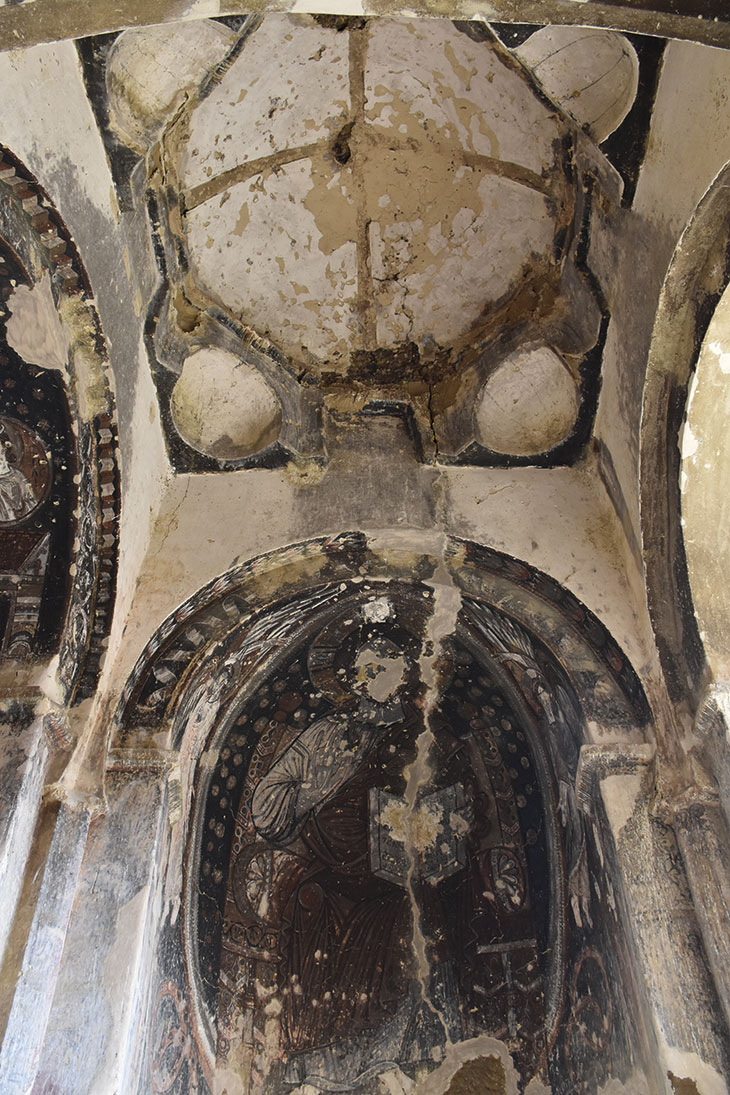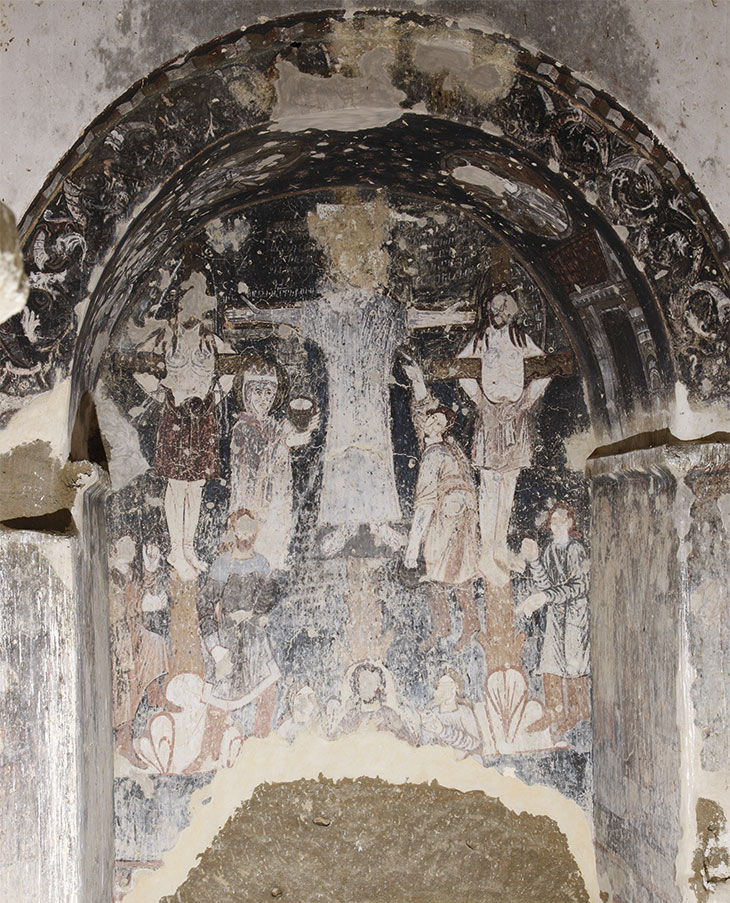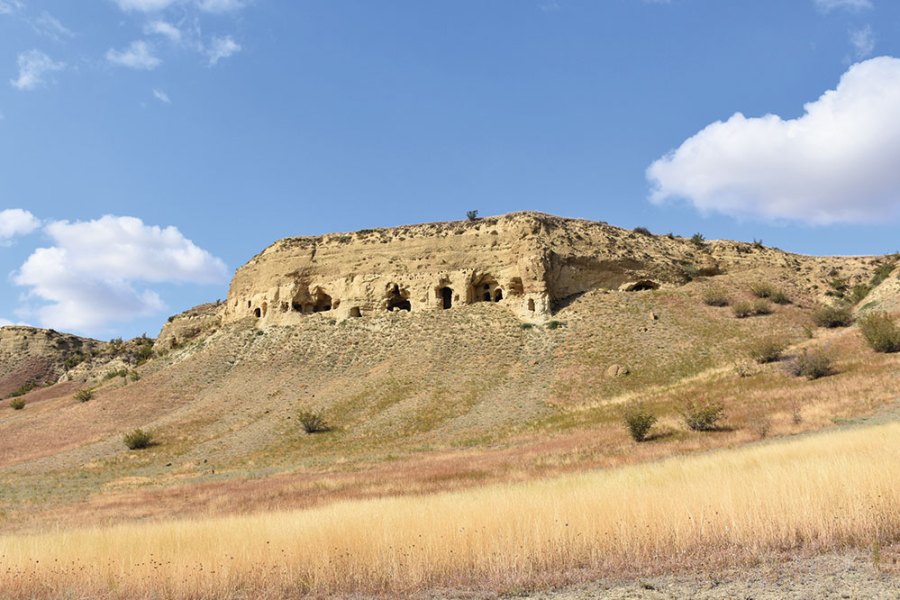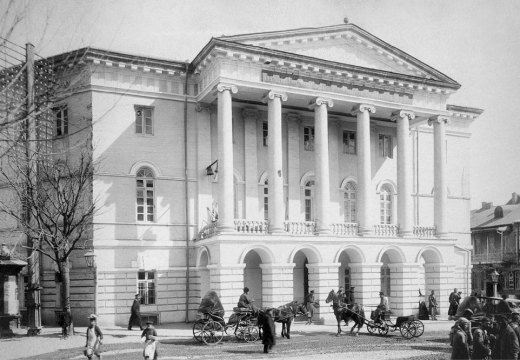From the September 2021 issue of Apollo. Preview and subscribe here.
In the late 1930s an article appeared in a local newspaper in a remote corner of Soviet Georgia. In it, an intrepid local school teacher named Dmitri Gonashvili described how, like some Howard Carter of the Caucasus, he had entered an ancient rock-hewn church covered in frescoes, seeing an icon set up on the altar as if ready for a service, and a chain for a lamp or censer hanging down from the centre of the painted dome above his head.
With that article, the ninth-century monastery of Sabereebi stumbled back into the historical record after a gap of several centuries. Gonashvili was perhaps the first visitor to the complex – a series of cave churches, cells and a refectory, all cut into a mighty sandstone cliff – since it was abandoned following the Seljuk invasions of Georgia in the 1060s (or, according to a different theory, since Mongol devastation of the area in 1265). There haven’t been many visitors since.
Sabereebi, ‘the place of the monks’, is carved into a cliff overlooking a waterless valley in Georgia’s only region of desert – a starkly beautiful scrubland that stretches down into Azerbaijan. For the full Indiana Jones experience it is best approached on horseback, with the five cave churches almost hidden until you are beneath them, at which point they loom like the enormous burrows of an oversize desert rodent. The frescoes within are extraordinary. The five principal churches (there are 11 in total) are separated by a refectory for 10 monks, with the father superior’s cell carved into a recess above it (now made inaccessible by rockfall). The churches feature porches, each leading into a domed chamber in a croix-libre design, a form beloved of ancient Georgian masons, in which four shell-shaped recesses support the weight of the dome – but in this case purely for ornamentation.

Interior of a cave church of Sabereebi, showing the domed ceiling. Photo: Salome Meladze
According to Zaza Skhirtladze, a professor of art history who has published the complete frescoes and inscriptions from Sabereebi, the design of the complex is a puzzle: ‘there were a small number of monks, maybe 10 with a father superior, so why did they need to build separate churches? And why so close to each other?’ The superb frescoes, which date from the ninth to tenth centuries, are also curious, with a different artist taking on the work in the porch and another in the main church – making for at least six separate artists, some of whom signed their work with requests for prayers to be said for them.
The frescoes bear similarities to the famous cave paintings of Cappadocia, and date from a time when the Byzantine empire, of which Georgia was a truculent neighbour and semi-vassal, had been racked with iconoclasm – which makes these paintings all the rarer. But stylistically, Sabereebi is all local. The artists themselves, who Skhirtladze says were monks, were most likely working on behalf of minor nobles from the vicinity – there is a donor portrait on the north wall of one of the churches. This gives them a different character from the royal, official paintings of the Georgian imperium of the 11th–13th centuries that make up the bulk of the country’s extant medieval art. Indeed, Sabereebi was probably abandoned before the Golden Age of medieval Georgia began in the late 11th century. The subjects depicted include a dramatic Crucifixion, Christ in Judgement with a throne covered in eyes, and wheels within wheels from the Book of Ezekiel. Most striking is the inclusion of two bright blue peacocks, painted with a form of copper oxide, which are a symbol of the Resurrection – and are helpfully labelled ‘peacock’ in old Georgian, just in case an unworldly, desert-dwelling monastic had never seen such a bird.

Fresco of the Crucifixion in a cave church at Sabereebi. Photo: Zaza Skhirtladze
Even in a country as dense with ancient Christian sites as Georgia (‘a church on every mountaintop’ might be its slogan), the frescoes at Sabereebi are notable for their age and condition. Still, they are a tiny remnant of what medieval pilgrims would have found in the area. Sabereebi was just a single point in a huge religious landscape that once covered this desert. It was here during the fifth century that an ascetic from Assyria, Saint Davit Garejeli, came to live the life of a hermit, praising God from the arid peaks. Davit, one of 13 Assyrians who introduced monasticism to Georgia, was surely reminded of the rocky wadis and desolate plains of the Holy Land, says Skhirtladze, when he began his mission here.
Davit’s piety, and his success in converting the local ruler, led to the foundation of the first monastery in the desert, the Lavra, in which he is buried. (After years of being used for target practice by the Soviet military, it was repopulated by Georgian priests in the 1990s; Skhirtladze was there when they opened St Davit’s tomb: ‘Very humble and very ascetic. He was a small man.’) By the ninth century, the time of Sabereebi’s establishment, about a dozen foundations had been created across these arid wastes – a landscape now known eponymously as Davit Gareja. At its peak perhaps 10,000 monks lived among the vultures and snakes.
Some of these monasteries are well known, especially Lavra and its sister monastery Udabno, whose frescoes, from the Georgian Golden Age, attracted a steady stream of tourists and pilgrims until border trouble with Azerbaijan in 2019 made it impossible to visit.
That dispute rumbles on, and some of the more adventurous tourists who would have gone to the other monasteries are now discovering Sabereebi instead, by way of an occasional offroad excursion that makes its way to the caves. Georgian cultural heritage specialists are also more regular visitors these days, monitoring the tremors that could bring the frescoes crumbling down – since Skhirtladze’s first visit in the 1980s, rockfalls have made parts of the complex inaccessible.
For all that Sabereebi has been rediscovered, the surrounding wilderness continues to harbour mysteries. Like Gonashvili before them, adventurous academics comb the area. Monasteries, untouched for centuries, are still being identified: Skhirtladze himself has discovered hitherto unknown martyriums, the pious monks of yesteryear lying serenely skeletal on their rocky shelves. Earlier this year, a team of archaeologists discovered a complete dome church cut into an inaccessible rock face a few miles east of Sabereebi. Slowly, the desert is giving up its secrets.
From the September 2021 issue of Apollo. Preview and subscribe here.
Unlimited access from just $16 every 3 months
Subscribe to get unlimited and exclusive access to the top art stories, interviews and exhibition reviews.














![Masterpiece [Re]discovery 2022. Photo: Ben Fisher Photography, courtesy of Masterpiece London](http://www.apollo-magazine.com/wp-content/uploads/2022/07/MPL2022_4263.jpg)
It’s time for the government of London to return to its rightful home